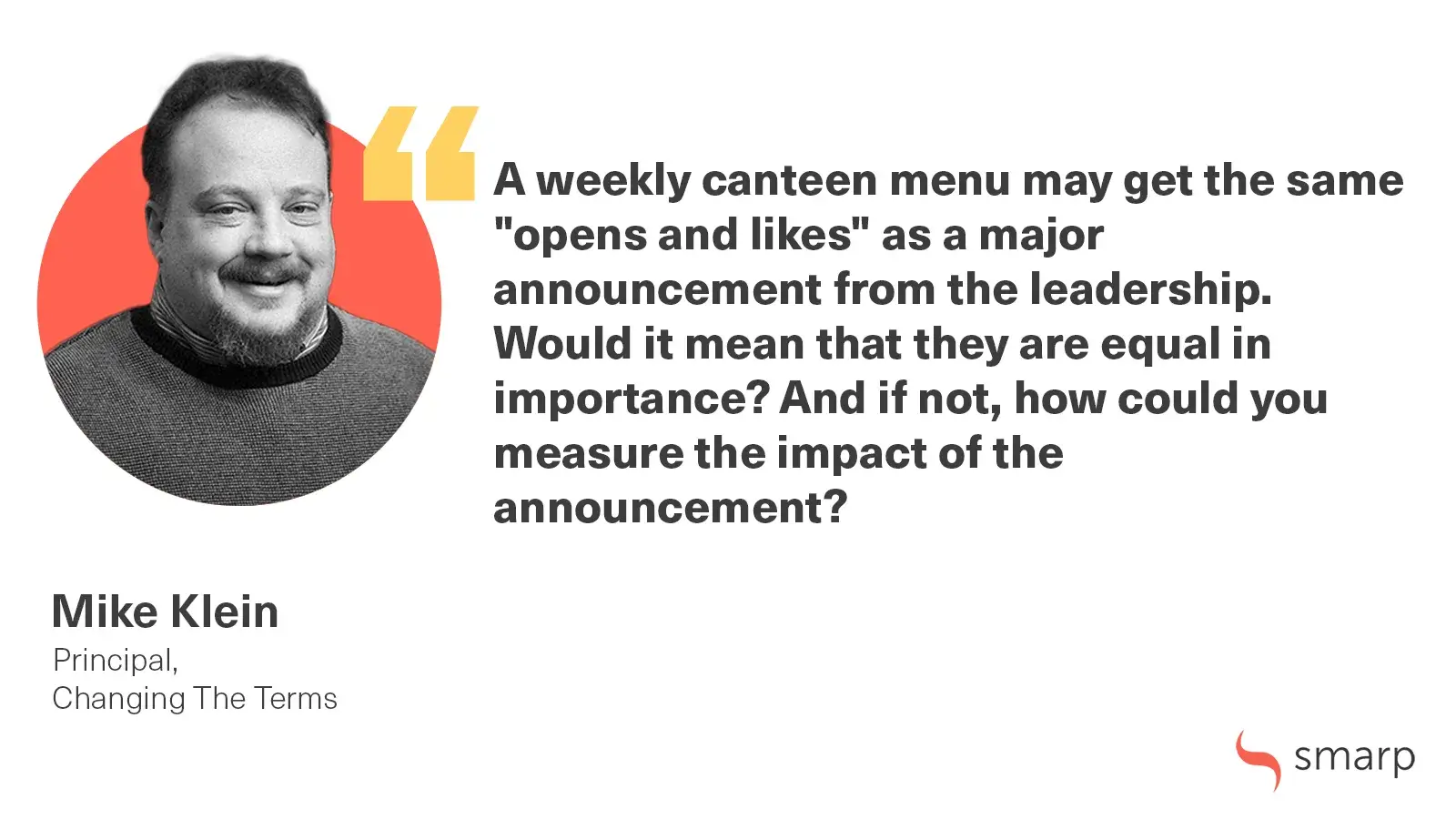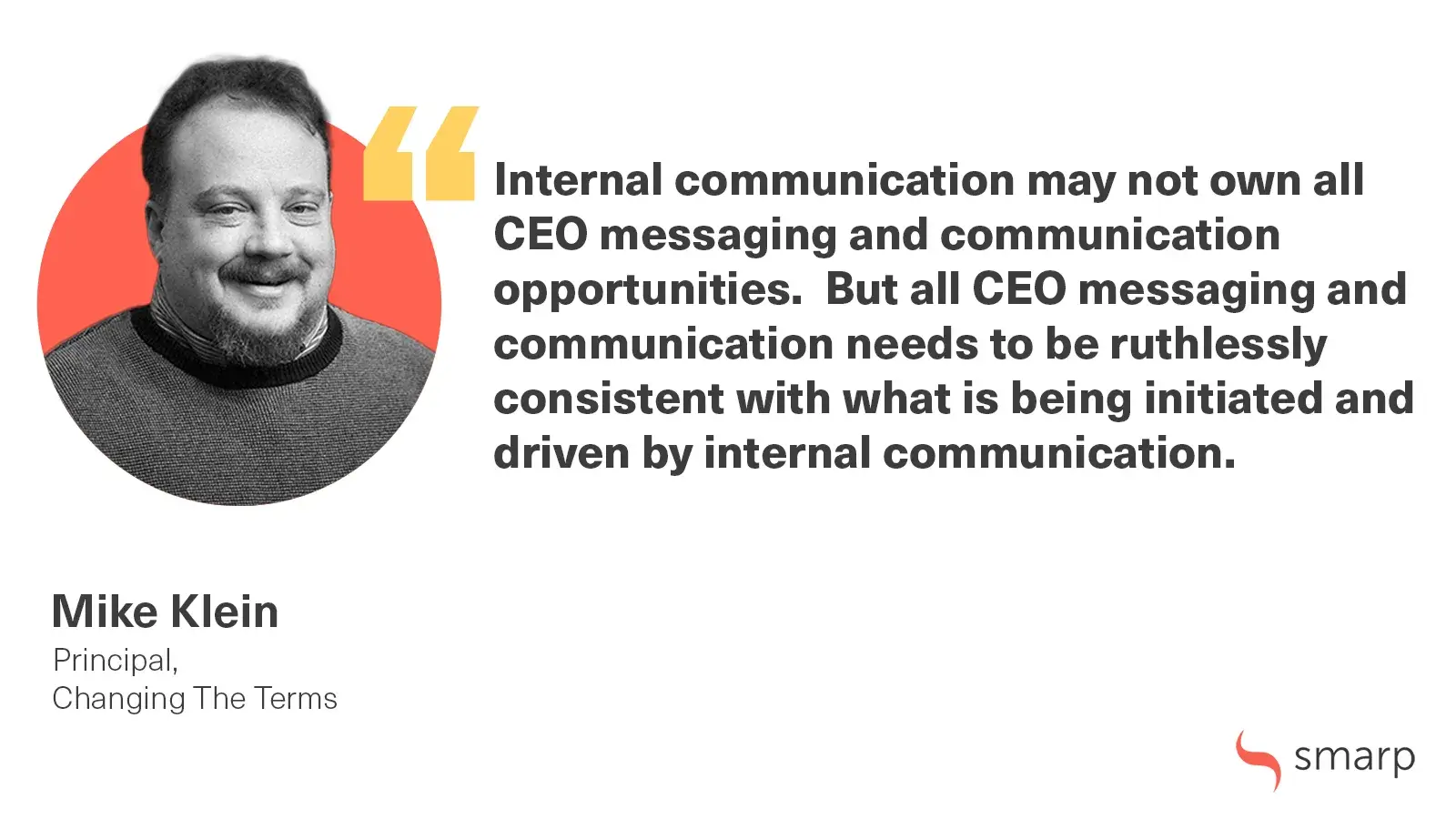As a leader in a large organization, you often have little time or bandwidth to focus on the scope or activities of individual functions. Your job is to make sure that the whole ship moves at the right speed and in the right direction, and that your direct reports are paying appropriate attention to their roles and the activities under their purview.
For the most part, that probably works fine. But one function in particular not only can benefit from added Chief Executive Officer attention, it also can magnify and deepen CEO impact when it comes to making sure the organization focuses on his or her priorities: internal communication.
Increase retention rates and alignment within your organisation with IC software
Why Is Internal Communication Important to the CEO?
Many of today’s CEOs have grown up in the hierarchical top-down mindset that emerged from World War II and is still at least somewhat in place throughout the world. From a communication perspective, the focus has been largely on the centralization of significant decisions at the top, and the “cascading” of those decisions from senior leadership through many layers of management.
The problem with the top-down mindset is that while hierarchy remains important for distributing resources, money and power within organizations, it has retained far less control over how messages and intent flow from one level to another, and particularly, of how ideas, messages and language are shared among employees and between employees and other key stakeholders: customers, public officials, opinion formers and even the media.

As much as Internal Communication is important in delivering formal messages that confirm top-level decisions, it also has substantial potential in addressing key issues in the organizational dynamic:
- Common context
- Clarified priorities
- Consistent language
- Regular reinforcement
- Feedback and Insight
Seeing the role of Internal Communication as focusing on these issues does not necessarily require a massive infusion or reprioritization of resources, nor does it require a shift in ownership away from a particular leadership function. IC functions often report to HR and Marketing, but they can successfully work under Operations, Finance, Sales, a significant Product Group or even the CEO herself.
It does require an understanding of how internal communication addresses these issues, and a willingness to allow the internal communication experts to allocate their time and resources to address the agreed priorities in accordance with their expert judgement. That may require the suspension or scaling back of certain activities or platforms that consume more than they add.
Measuring Internal Communication — a Willingness to Combine Art With Science
Internal communication is non-linear. Consider a 300-word canteen menu and a 300-word statement rejecting an offer of acquisition.
On the surface, the rejection statement is much more important. It took a lot longer to produce. And it is a well-crafted, heart-stirring statement of organizational vision and principles combined with leadership resolve, one designed to give heart and confidence that things will continue as “normal” for the foreseeable future.
Yet, in nearly every organization, the canteen menu is probably the most-read piece of internal communication. It galvanizes a tangible behavior — managing flow of hungry employees to their canteen(s).
Even if the menu and the statement got equal “opens and likes” – would they be equal in importance? And if not, how could you measure the impact of the statement?
There are a number of ways to measure the internal impact of the statement – but none of these ways is possible without an explicit willingness to measure. Yes, you can use click and open rates, but those alone as raw data provide little in the way of insight or an understanding of sentiment. The real value comes when you link your data to your company’s business goals, but it requires the next generation analytics suite.

Creating Common Context
As a Chief Executive Officer, you have responsibility for the whole of your organization. And you know that your organization isn’t a massive To-Do list or a bunch of boxes and lines on an org chart. Those things are all important, but they are not why you exist, why you do what you do, and what your employees are to focus on when they sign in – or log in – every morning.
You probably know what that “why” is.
If you do, the job becomes to make sure that “why” is understood and embraced by all of your people, such that it is equally obvious and understandable.
If you don’t, then it’s possible to construct a coherent, defining story that pulls your organization’s common elements together and puts you in the position to lead and support its delivery as a means of renewing your organization’s collective context.
With it’s businesswide scope and an ability to generate content and media and collect and analyze feedback, Internal Communication gives you the ability to amplify, broadcast, narrowcast, refine and query your context story and the extent to which it is being understood and accepted throughout your organization.
One area where Internal Communication can help is in looking closely at how you define your overall context, which usually consists of a combination of “purpose,” “vision” and “values” and the more tangible top-level “priorities” which are intended to drive business behavior.
📚 Read on: Company Values: Definition, Importance and Examples
If inconsistencies are identified, Internal Communication can work with you to either correct the inconsistencies in a positive and empowering way, or to put them in the perspective of your organization’s larger objectives. Or you may opt to leave them unaddressed. In any event, by identifying the inconsistencies, it becomes possible to monitor and, if desired, manage their impact on organizational credibility and the perceived importance of the overall agenda.

Clarified Priorities
Businesses are prioritization machines. Everyone, at every desk and workstation, is working to what they see to be the day’s priorities.
The question for most, if not all, organizations is the extent to which each individual’s priorities either roll up to a common set of priorities that should drive the entire business, or reflect the unaligned individual agendas of employees, or of managers with their own sets of ambitions.
One reason why a given organization might not do a great job at aligning priorities vertically is that the top-down internal communication is either inadequate or missing entirely.
In part, this is because of the persistence of ineffective communication practices, such as the use of top management conferences and other events as start of “communication cascades” – which, while intended to stimulate a resonant and unaltered flow of critical information that ultimately reached every employee, instead often delivered muddled messages, variable degrees of management enthusiasm and, perhaps blatantly, tweaked and rearranged priorities.
💡Read on: Mike Klein on Why Internal Communication Is Actually Multidirectional
The role of the management conference as a communication activity persists because of a belief in economization over effectiveness. Having spent (hundreds of) thousands of dollars on hotel rooms, fancy catering, top-shelf audio-visual and (business-class) plane tickets, many organizations believe that one way to spread out that cost is to task out the management with the delivery of the annual strategy messages that are deemed to be given there on stone tablets.
The easiest way to get rid of this false economy isn’t to cancel the management conference. But hoping for an effective cascade is a pipe dream. It’s also taking place in an era where technology allows you (CEO) to reach most of your audience at one time. Global meetings are now within the realm of possibility and global, direct messaging with employees is also quick and cost-effective.
🎧 Tune in: Creating a Dialogue with the Hard to Reach with Maria Ljungbeck (Podcast)
Priorities
At a top level, the way to communicate clear priorities is to define clear priorities. That involves two basic tasks: identifying the tasks and initiatives that are most important, and having the discipline to recognize how important each is relative to the others.
This sounds simple, but it can be very hard.
It’s not uncommon for organizations to abdicate their responsibility to drive prioritization. Some punt the decisions to prioritize downward, ostensibly to “empower” but often stoking disputes between teams and functions. Others simply decide that a large group of activities and initiatives are equally critical, and actively discourage any unofficial prioritization within that agenda. In such situations, actual prioritization ends up being driven by the urgency of tasks rather than what will move the needle for the organization as a whole.
But if you have the discipline to drive prioritization and proritization processes (which may be needed in larger enterprises) in coherent ways, internal communication can play a significant role in focusing people on engaging with the things that are priorities, and shift excess activities and resources away from things that are lower down the list.
Internal communication can bring your priorities to life in a number of ways:
-
- Define – explain what the priority is, and what the priority isn’t
- Position – articulate the relationship between the priority and the organization’s larger ambition(s)
- Exemplify – tell and elevate the stories of those who are succeeding at making the priority happen, or those who are working exceptionally hard in that direction
- Scorekeeping – measure and share quantified progress towards a specific numerical goal
- Challenge – give voice to leaders who can call on colleagues to dig deeper, or to query practices and habits that may be holding progress back
- Contextualize – put the importance of a priority inside of a larger perspective of what is happening in the business, the economy or in society.
Consistent Language
Businesses are run by numbers. That is commonly known and understood. What is less known and understood is that they also need to be run with consistent language.
This doesn’t always work in practice. A classic scene from one of my consulting assignments illustrates. The client team and a team from a major brand-name consultancy were discussing the role of “partners” within a project. Two groups of highly intelligent people. Yet they spent two hours going nowhere and getting to the point of yelling. Then, finally, someone from the client team asks “what do you mean by partners,” “Anyone outside of your company and ours who we work with on the project: said the consulting team leader. “That’s interesting, we use the term to describe anyone else we work with – internally or externally.” One term, two very different groups of people. And substantial potential for unproductive argument.
Inconsistent language can drive misaligned behaviour and add confusion and hesitation to decisions and customer encounters.
Can internal communication help drive language consistency? Absolutely. It can introduce, reinforce and circulate correct terminology and also challenge and question the use of similar terms which are insufficiently specific.
The secrets to using consistent business-critical language are discipline and repetition. The discipline to avoid falling into shorthand, and willingness to continuously use the terms which need to be commonly understood and consistently used.

Leaders and managers can be helpful, but conscious effort to define, refine and reinforce consistent terminology through internal communication channels and activities can do the heavy lifting.
One additional area to look at is the challenge of harmonizing key business terms in multilingual organizations.
There tends to be three ways to do this. The first is to take the accepted English terms and then come up with local-language definitions that align as fully as possible with the official English.
The second is to stick with local language but ensure that individuals who are key interactors with other parts of the organization can make sure that any ambiguities are kept to a minimum.
The third is to embrace an acronym or some jargon that could be used in all language areas but can be defined similarly in each operating language. While some comms experts discourage the use of jargon in any way ( a prime example being Gabrelle Dolan), the multilingual use of specific bits of corporate jargon can have the added bonus of strengthening organizational cohesion while minimizing ambiguity. When you have people across the company working on the “PRNEP” or the “EPHNS” programs, people outside the “English Zone” often embrace the acronyms without translating them – often pronouncing them phonetically according to their language’s rules. This may cause some minor degree of getting used to, but it also speaks to a sense of participation or shared ownership — which would be missed if everything was communicated in official simplified dejargonized English. (It is also worth noting that new employees, particularly those working remotely, will need considerable help being introduced to new language and indeed to the required information and connections that will allow them to function quickly and effectively in their new organization).
Regular Reinforcement (and the Internal Role of Executive Communication)
Moving from aligning the messages and the language, we then reach the point where the role of the CEO as a communicator comes to the fore.
All of the context messages and all priority content needs to be continually and continuously reinforced: why are we doing what we do, and what is (and isn’t) absolutely important.
The paradox is that the CEO is not exclusively dedicated to internal messaging and to formal communication, but what you say is continuously audible and visible to internal people and audiences, and that internal people and audiences can share and rebroadcast anything that’s out of kilter.
📚Read on: 18 Leadership Communication Trends to Look For in 2020
Internal communication may not own all CEO messaging and communication opportunities. But all CEO messaging and communication needs to be ruthlessly consistent with what is being initiated and driven by internal communication. When it comes to working with the CEO, the communication team needs to fully work as a team, focused on consistency internally and externally, and ensuring that you speak to the overall organizational story in a disciplined yet human way.
You don’t have to own regular channels for reinforcing key themes, messages and priorities, though these can be helpful in reaching specific people and audiences, or in providing ongoing reassurance more broadly. There is no hard rule – the only hard rule is that communication needs to be human, consistent, honest and appropriately frequent.

Feedback and Insight
A key driver of frequency, one that is extremely helpful in providing guidance in adjusting the tone and language of messages as well, is a methodical approach for collecting feedback and insight from the internal audience on a systematic basis.
Ideally, a modern organization should be simultaneously collecting feedback and insights through three different sources:
- Embedded measures in one’s internal communication platform (such as Haiilo Stories’ Workforce Insights)
- Ongoing qualitative surveys and collections that focus on words and meanings (like asking participants to recall, rate and rank terms used in internal messaging)
- Trends in organizational performance identified as organizational priorities
It should also monitor feedback available in public sources, including Glassdoor and Vault (especially since Glassdoor collects current and former employee ratings of CEOs).
One additional source used often in organizations should be used with a certain amount of caution – the employee engagement survey (such Haiilo Insights).
If your company has invested in a modern internal communication platform, a key benefit will include the ability to monitor and track consumption and usage to some degree.
Quantitative research is not just a source of insight, it is a source of power. It can demonstrate organizational reality at a time when it is seen as ambiguous, and, for that matter, a belief in ambiguity can reopen questions and priorities.
Still, qualitative insight can take that power to a new level. Qualitative research, most powerfully, can address both how people feel about what is going on, what they hear, and what they think is important, and what they don’t recall, don’t mention, and don’t rate. In organizations where support – or compliance – with the organizational agenda is both demanded and assumed, it is qualitative research that can identify big gaps in awareness, acceptance and action.
Qualitative research can be done through interviews or through open-ended online surveys, but it doesn’t need to be used on the entire population to gain useful insights. If there is a desire to use easier-to-analyze closed-ended tools, rating or ranking questions can ask participants to address the importance or favorability or certain items that will go beyond the insights offered by purely quantitative tools.
If your organizational agenda is driven by aims to change specific key performance indicators (KPIs), then it becomes critical to monitor those closely and look at when and whether related communication activities coincided with shifts in the KPIs. It is hard to make a conclusive determination when an internal communication initiative resulted in a KPI jump, but it is possible to investigate if you are aware one potentially occurred in relation to the other.
Are You Sure This Is My Job?
It is not the job of the CEO to be the head of internal communication. But as the CEO drives the commercial and the performance agenda, the extent to which an understanding and acceptance of that agenda spreads widely and unambiguously through the organization will play a crucial role in your success. In other words, it’s not your job, but it may determine the success of your job.
Context, content and above all priorities are at the heart of a CEO’s internal communication agenda. When context goes missing, people find it easy to come up with their own priorities, based on their sense of what they think is best. When content goes missing, people miss out for detail or start making assumptions. The impact of either is far more expensive than the bits of leadership attention required of the CEO to provide vision and clarity.
Internal communication needs real measurement if it is going to support the business in real time. It requires time, energy and a bit of money sometimes. But usually far less of any of these than it takes to rescue a strategy that’s been left to run aground.
It’s not your job to do all of the work, but you do need to do your part both as a communicator and in ensuring that Internal Communication has the tools and insights it needs… to help you do your job.










